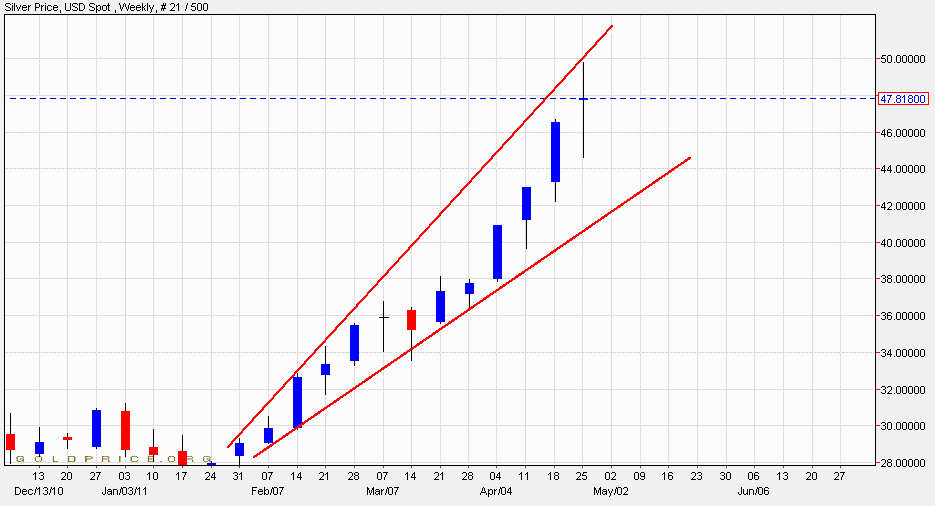Throw out certainty when trying to predict silver's future
Posted: 05/06/2011 02:42:01 PM PDT
Updated: 05/06/2011 05:14:01 PM PDT
http://www.contracostatimes.com/business/ci_18010388?nclick_check=1
http://www.contracostatimes.com/business/ci_18010388?nclick_check=1
"Silver will reverse course anytime now." "... "It will go sideways for awhile before going back up." "... "It's just in a correction period, but a year from now we could see it close to $100 an ounce."
Ask three experts what's going to happen to the precious metal in the coming weeks and months, and you could get three different answers. The only certainty is that no one knows what will happen next."I think it has every reason to level off and eventually go back up again, but every idea needs to be taken with a grain of salt because no one knows for sure," said Barnaby Levin of financial firm HighTower Advisors in San Francisco. "It's going to be dicey to say what's going to happen next."
Coming off an 84 percent run-up in 2010 followed by the first four months of this year in which it out paced gold, the floor has given out on silver as it fell for five straight trading sessions, finishing its worst week Friday in 35 years. It's currently trading at $35.29 an ounce. The tumble came after CME Group, the Comex owner, nearly doubled the cash amount needed for margin buying of the metal.
"We can wake up tomorrow and it could be $40 or it could be $30," said Barry Stuppler, president of the California Coin and Bullion Merchants Association in Woodland Hills. "For the long term, I think silver is a good investment, but for the short term, if you're a person that has trouble sleeping at night if it goes down $5 all of a sudden, it might not be the best investment."
While not as popular to invest in as gold, silver's recent run-up has drawn more interest than in the past. Wealth managers say many of their clients are asking about silver more than usual.
"The scariest thing about gold and silver is when everyone is touting it," said Carlo Panaccione, a financial planner and president of the Navigation Group in Redwood City. "Typically, when everyone jumps on the same train is the time to get off."
Panaccione advises his clients to put no more than 5 to 10 percent of their total portfolio into commodities such as silver. Others who have clients who invest more aggressively might advise as high as 20 percent.
Often referred to as "the poor man's gold," silver is popular to those who want to own metal but don't want to pay the nearly $1,500-an-ounce premium that gold dictates.
"Buying silver versus gold is like buying stocks in General Electric versus Berkshire Hathaway, you get more for less," Levin said. "But you don't want to back up the truck and buy it today, because while silver has value right now, you should expect it to go down."
The one problem with buying physical silver is that it's heavy.
"If you want $10,000 worth of silver, it's much harder to store in your mattress than gold," Levin said.
For those who want to invest in silver, there are several ways. The two most popular are through an exchange traded fund such as SLV, or through buying physical silver such as an American Silver Eagle.
Those who are merely attaching the investment to the price of silver often get the ETF. However, others, who use the investment as a hedge against inflation and envision a financial catastrophe, are often advised to hold onto the physical silver.
"It's like if your house is on fire, would you rather have a fire extinguisher or a picture of a fire extinguisher?" said Nick Barisheff, president and CEO of Bullion Management Group in Toronto.
Unlike gold, which has little use outside of jewelry, there is a greater use for silver in many industrial sectors. Properties such as its high electrical conductivity, reflectance of light and ability to endure extreme temperature ranges make it valuable to industries. Thus the conclusion can be made that there will always be some demand for silver on some level.
Even though silver is in a struggle, Barisheff says it historically trades at a price ratio of about 16-to-1 that of gold. Given that, he believes eventually, "It should be twice the price that it currently is."

![[Most Recent Quotes from www.kitco.com]](http://www.kitconet.com/charts/metals/silver/t24_ag_en_usoz_2.gif)
![[Most Recent Quotes from www.kitco.com]](http://www.kitconet.com/charts/metals/silver/t24_ag_en_bpoz_2.gif)
![[Most Recent Quotes from www.kitco.com]](http://www.kitconet.com/charts/metals/silver/t24_ag_en_euoz_2.gif)
![[Most Recent Quotes from www.kitco.com]](http://www.kitconet.com/charts/metals/silver/t24_ag_en_yeoz_2.gif)
![[Most Recent Quotes from www.kitco.com]](http://www.kitconet.com/charts/metals/silver/t24_ag_en_cnoz_2.gif)
![[Most Recent Quotes from www.kitco.com]](http://www.kitconet.com/charts/metals/silver/t24_ag_en_inoz_2.gif)






